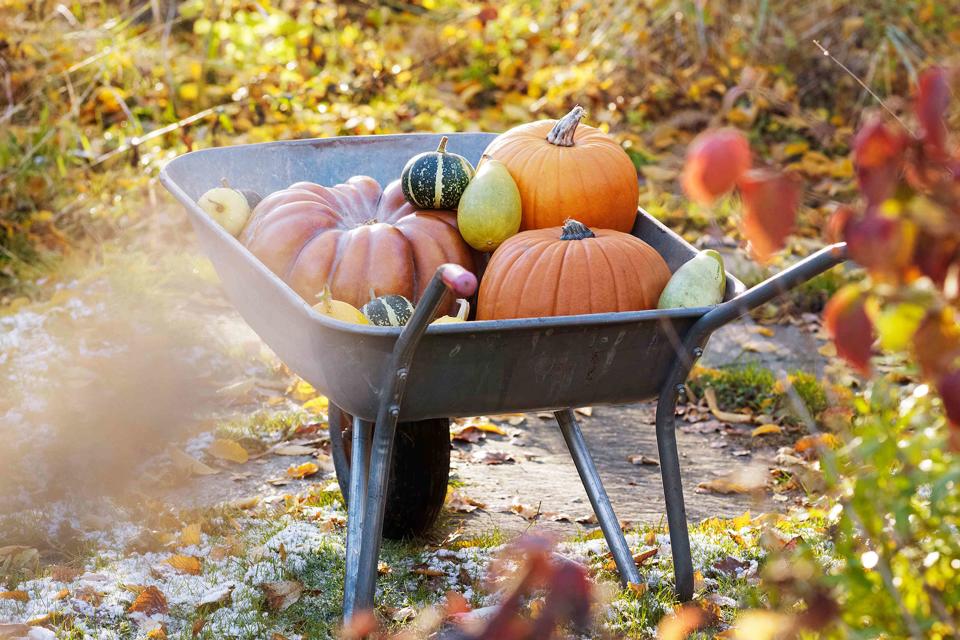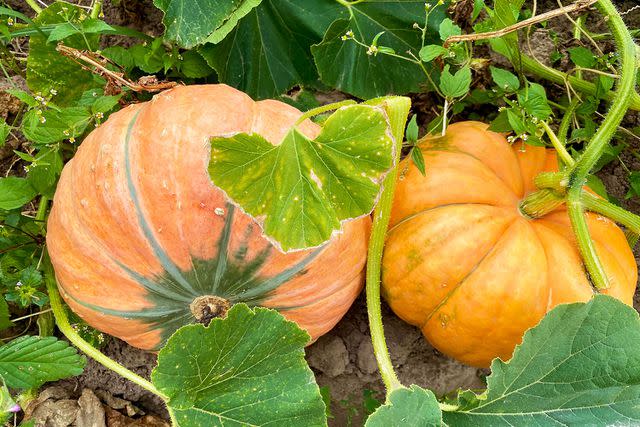When to Plant Pumpkins—Plus Tips on Ensuring a Successful Crop
Gardening experts share their tips for growing your own pumpkins at home.

Getty Images
Skip the pumpkin patch this year and grow your own pumpkins at home. Planting and harvesting this fruit is something gardeners of all skill levels can do. In just a few months, you'll have your own pumpkin supply to make pies and other autumnal dishes; plus, you'll even have plenty left over for jack-o'-lanterns. To ensure a healthy crop, we spoke to gardening experts who shared their tips for how and when to plant pumpkins.
Meet the Expert
Joe Ailts, board member of the St. Croix Giant Pumpkin Growers Association, a non-profit giant pumpkin club representing the Minneapolis and St. Paul, Minnesota greater metropolitan area
Carrie Spoonemore, co-creator of Park Seed's From Seed to Spoon app, an app that makes garden planning easier
Related: 14 Types of Pumpkins You'll See This Fall
When to Plant Pumpkins
The best time to plant pumpkins is mid to late May once the threat of frost has passed. "This provides ample time for the pumpkins to grow to maximum size," says Joe Ailts, board member of the St. Croix Giant Pumpkin Growers Association.
How to Plant Pumpkins
When planting pumpkin seeds, choose an area of your garden that gets full sunlight and has well-draining soil. The spacing depends on the variety of pumpkin you're growing, but typically they should be several feet apart, says Carrie Spoonemore, co-creator of Park Seed's From Seed to Spoon app.
Create mounds of soil about 1 to 2 feet apart. Plant 2 to 3 seeds per mound at about 1 inch deep.
Water each mound well.
Once the seeds germinate, thin them out to leave the healthiest plant per mound.
Starting Pumpkin Seeds Indoors
Get a jumpstart on growing pumpkins by starting the seeds indoors. "One seed per 4-inch pot is an ideal balance of sufficient pot size without overwhelming need for space," says Ailts. Start the seeds about two to four weeks before the last frost date in your area.
Fill 4-inch pots with seed starting mix.
Sow one seed per pot, about 1 inch deep.
Place the pots in an area with full sun. (Use a grow light if needed).
Keep the soil consistently moist.
Once the seedlings have developed several true leaves, transplant them outdoors in spring.
Tips
When starting seeds indoors, don't let the seedlings get too big in their containers. "If they become root-bound it can take a while for the plants to bounce back," says Ailts. If they outgrow their pots before the threat of frost has passed, transfer the seedlings to larger containers until they can safely be planted outside.

Helaine Weide / Getty Images
Related: How to Plant, Grow, and Harvest Spaghetti Squash
Best Types of Pumpkins to Grow
There are a great many pumpkin varieties you can grow at home. These are some of the most common:
Connecticut Field: This is a popular heirloom variety that's good for cooking or carving, says Spoonemore.
Wee-B-Little: A miniature variety, Wee-B-Little pumpkins are perfect for small gardens or those who prefer small pumpkins, says Spoonemore.
Lumina: Ideal for painting, Lumina pumpkins are medium sized, white-skinned variety.
How to Care for Pumpkins
Sunlight
Pumpkins should be grown in an area that receives a least six to eight hours of full sun per day, says Spoonemore.
Water
Consistently water your pumpkins around the base of the plant so the soil stays moist, but be sure not to waterlog the soil, which can lead to root rot. About 1 to 2 inches of water per week is ideal, says Ailts.
Soil
Pumpkins thrive in nutrient-rich, well-drained soil with neutral to slightly acidic pH, says Spoonemore.
Fertilizer
Pumpkins can benefit from an application of a balanced fertilizer when the vines begin to develop and again when fruit starts to form, says Spoonemore.
Temperature
Pumpkins need warm temperatures in order to grow. They thrive when the weather stays between 65 to 85 degrees Fahrenheit, says Ailts.
Related: 4 Ways to Prevent Squirrels (and Other Animals) From Eating Pumpkins, Gourds, and More Fall Décor
Pruning Pumpkin Plants
There are many benefits of pruning pumpkins. "Pruning pumpkins can help improve airflow, reduce the risk of diseases, and increase the size and quality of the fruits," says Spoonemore. "Remove any dead or diseased leaves, as well as any excess foliage that shades the fruits. This will allow more sunlight to reach the fruits, promoting their growth and ripening."
Harvesting Pumpkins
Pumpkins take about 100 days to grow from seed to harvest. You'll know they're ready to be harvested when the rinds are hard and the stems start to dry out and turn brown, says Spoonemore. To harvest, use a sharp knife to cut the pumpkin from the vine, leaving a few inches of stem attached.
Curing Pumpkins
Curing pumpkins after harvesting them can extend their lifespan. Place the pumpkins in a warm, dry area with consistent airflow for about ten days to cure. Make sure the area is well-ventilated and the pumpkins aren't touching each other. "This process is crucial as it helps harden the pumpkin skin, making it less susceptible to rot," says Spoonemore.
Storing Pumpkins
Store pumpkins in a cool, dry area, like your garage or basement. "Avoid leaving the pumpkins directly on the ground, which can cause rot," says Spoonemore. "The best solution is a metal wire rack or shelving that allows airflow. Check them periodically for signs of pests or rot, and use any that show soft spots or damage as soon as possible."
Overwintering Pumpkin Plants
Harvest pumpkins before the first frost—after that, the plants don't need much care during winter. "Alternatively, you can cover the vines with mulch or row covers to protect them from frost," says Spoonemore.
Related: What Are Gourds—and Are They Safe to Eat?
How to Save Pumpkin Seeds
The easiest way to propagate pumpkins for next year is by saving the seeds.
Cut the pumpkin open and remove the seeds.
Put the seeds into a colander pan and rinse with tepid water.
Use your hands to remove any pulp.
Place unbleached coffee filters over a cookie sheet and lay the seeds over the filters in one layer.
Let the seeds dry, turning them over after a few days to prevent rot.
Once the seeds are dry, store them in envelopes in groups of 10 and store them in a cool, dry location.
Common Problems
Pumpkins can be susceptible to certain pests and diseases. One common bug is aphids, which feed on the underside of leaves. Treat aphids with insecticidal soap or by spraying the foliage with water. Squash beetles and cucumber beetles are also common pests that affect pumpkins. Regularly inspect foliage for these insects and pick them off as they arise. If you have an infestation, pesticides safe for edible plants may be necessary.
Powdery mildew is one of the most common diseases that affects pumpkins. It appears as white fungal patches that arise on plant leaves and stems. While it rarely kills plants, it can be difficult to treat. The best way to avoid powdery mildew is to grow pumpkin varieties that are resistant to this disease.
Read the original article on Martha Stewart.

